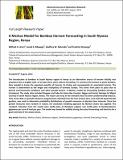| dc.contributor.author | Arori, Wilfred; Kibwage, Jacob; Netondo, Godfrey; Onyango, Fredrick | |
| dc.date.accessioned | 2020-08-17T07:06:18Z | |
| dc.date.available | 2020-08-17T07:06:18Z | |
| dc.date.issued | 2013 | |
| dc.identifier.citation | 2 | en_US |
| dc.identifier.uri | https://repository.maseno.ac.ke/handle/123456789/2133 | |
| dc.description.abstract | The Markov model applied to bamboo growth and harvest helps determine expected harvest, given survival probabilities at various stages of bamboo growth. The introduction of bamboo in South Nyanza region in Kenya as an alternative source of income met with pessimism due to the wait of at least three years before harvesting. To convince farmers to plant bamboo, they needed to know the expected quantity of harvest, its timing and consequently its associated income. Related findings show that bamboo is four times more profitable than tobacco and more than tenfold when processed into high quality bamboo products. | en_US |
| dc.publisher | IDRC | en_US |
| dc.subject | Bamboo, Markov chains, Bambusa vulgaris, Dendrocalamus giganteus, harvest forecasting, Kenya. | en_US |
| dc.title | Markov model for bamboo harvest forecasting in South Nyanza region, Kenya | en_US |
| dc.type | Article | en_US |

